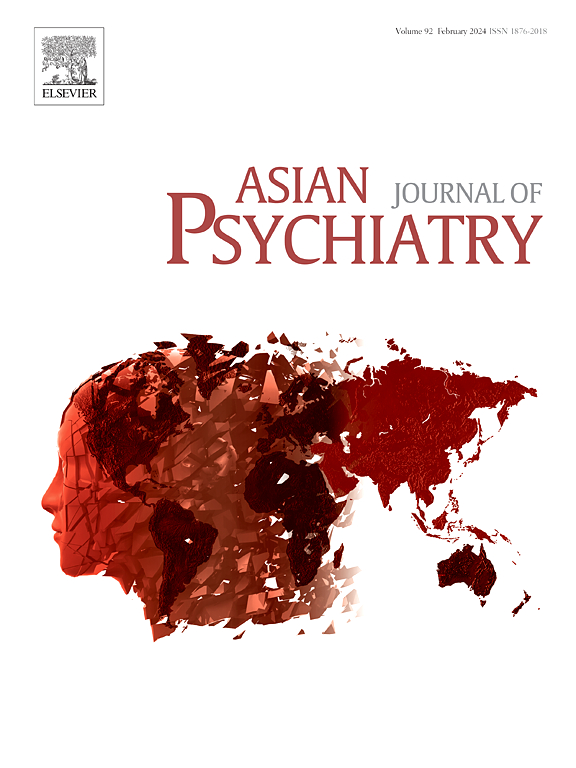Assessment of vestibular dysfunctions in schizophrenia and bipolar disorder – A comprehensive systematic review
IF 4.5
4区 医学
Q1 PSYCHIATRY
引用次数: 0
Abstract
Background
The vestibular system is closely linked to brain regions such as hippocampus, thalamus, and prefrontal cortex involved in self-perception, spatial orientation, and emotional regulation. Disruptions in these pathways may underlie symptoms such as hallucinations or mood instability, with emerging evidence suggesting a role of vestibular dysfunction in the clinical features and comorbidities of schizophrenia and bipolar disorder.
Objective
The aim of this systematic review was to critically examine the available data on vestibular dysfunction in individuals with schizophrenia and BD, explore possible mechanisms, and evaluate the clinical implications, including therapeutic relevance.
Methods
Following PRISMA guidelines, we searched PubMed, Scopus, Web of Science, Cochrane Library, and HTA Database (Jan 2000–Apr 2025) for peer-reviewed studies assessing vestibular function in adults with BD and/or schizophrenia using quantitative methods. Study quality was appraised with the Cochrane Risk of Bias Tool and Newcastle-Ottawa Scale. The review is registered on PROSPERO (CRD42024124991).
Results
Of 854 records, five studies (four cross-sectional, one RCT) met inclusion criteria, using posturography and electrovestibulography to assess vestibular function. Both BD and schizophrenia showed vestibular abnormalities: BD exhibited state-dependent changes during mood episodes, while schizophrenia showed illness-related visual dependence. Vestibular dysfunctions were also linked to cognitive deficits and anxiety. Limitations included small samples, medication effects, and heterogeneous methods.
Conclusion
This review highlights preliminary evidence that vestibular dysfunction is an underrecognized feature of schizophrenia and BD. Integrating vestibular assessments may improve diagnosis and guide rehabilitation, while longitudinal studies are needed to clarify causal links and therapeutic potential.
评估精神分裂症和双相情感障碍的前庭功能障碍-一个全面的系统综述。
背景:前庭系统与海马、丘脑、前额叶皮质等参与自我感知、空间定向和情绪调节的大脑区域密切相关。这些通路的破坏可能是幻觉或情绪不稳定等症状的基础,新出现的证据表明前庭功能障碍在精神分裂症和双相情感障碍的临床特征和合并症中的作用。目的:本系统综述的目的是严格检查精神分裂症和双相障碍患者前庭功能障碍的现有数据,探索可能的机制,并评估其临床意义,包括治疗相关性。方法:根据PRISMA指南,我们检索PubMed、Scopus、Web of Science、Cochrane Library和HTA数据库(2000年1月至2025年4月),以定量方法评估双相障碍和/或精神分裂症成人前庭功能的同行评审研究。采用Cochrane偏倚风险工具和Newcastle-Ottawa量表评价研究质量。该审查已在PROSPERO注册(CRD42024124991)。结果:在854份记录中,有5项研究(4项横断面研究,1项随机对照研究)符合纳入标准,使用姿势摄影和前庭电图评估前庭功能。双相障碍和精神分裂症均表现出前庭功能异常:双相障碍在情绪发作时表现出状态依赖性改变,而精神分裂症表现出疾病相关的视觉依赖性。前庭功能障碍还与认知缺陷和焦虑有关。局限性包括样本量小、药物效应和异质性方法。结论:本综述强调了前庭功能障碍是精神分裂症和双相障碍未被充分认识的特征的初步证据。整合前庭功能评估可以提高诊断和指导康复,但需要纵向研究来阐明因果关系和治疗潜力。
本文章由计算机程序翻译,如有差异,请以英文原文为准。
求助全文
约1分钟内获得全文
求助全文
来源期刊

Asian journal of psychiatry
Medicine-Psychiatry and Mental Health
CiteScore
12.70
自引率
5.30%
发文量
297
审稿时长
35 days
期刊介绍:
The Asian Journal of Psychiatry serves as a comprehensive resource for psychiatrists, mental health clinicians, neurologists, physicians, mental health students, and policymakers. Its goal is to facilitate the exchange of research findings and clinical practices between Asia and the global community. The journal focuses on psychiatric research relevant to Asia, covering preclinical, clinical, service system, and policy development topics. It also highlights the socio-cultural diversity of the region in relation to mental health.
 求助内容:
求助内容: 应助结果提醒方式:
应助结果提醒方式:


